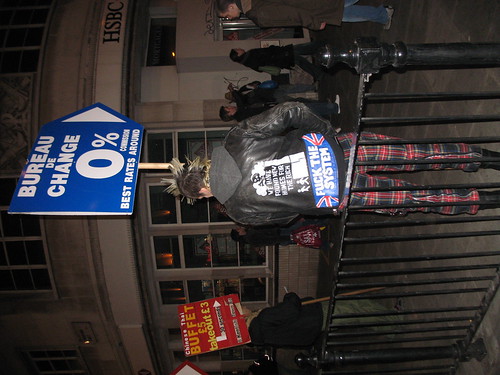The Null Device
Posts matching tags 'camden'
2014/1/15
Writing in the Torygraph, Alex Proud (of Proud Galleries) bemoans the “Shoreditchification” of London, the process by which the phenomenon of hipster culture (by now, heavily leveraged with marketing) seizes rundown areas of the city and forcibly makes them over, raising rents, replacing local shops with gimmicky bars catering to affluent 26-35-year-olds, and ultimately leaving them open for the bankers and Foxtons to take over; sort of like the Shock Doctrine, only with ironic facial hair and upcycled furniture:
You find a previously unnoticed urban neighbourhood, ideally one that’s a bit down on its luck. Pioneer hipsters move in and coolhunters ensure it starts trending on Twitter. A year later, the mainstream media notices and, for the next 12 months, the neighbourhood is byword for urban cool. Soon property prices soar pushing the original residents out, the bankers (always a trailing indicator) begin to move in and a Foxtons opens. Finally, the New York Times runs a piece in which it “discovers” the area and the cycle is complete. The last hipsters move on and find a new neighbourhood to play with.Shoreditch, Proud asserts, is long past the terminal phases of this phenomenon, being a “cold-climate Aiya Napa”, frequented by stag-party tourists from Essex. Dalston, the hipster haunt of recent years, is past it as well (despite there still being completely unhip and unironic Turkish restaurants alongside the basement DJ bars and Giorgio Moroder-themed pizza joints; never mind, though, by the time Kanye West and Kim Kardashian open their matching fashion shops in Dalston and the Essex stag parties start negotiating the Overground in to take in its lad-mag-certified cool, it will doubtlessly be as dead as a doornail), with Peckham being about to be jettisoned for somewhere further out; possibly even, Proud reckons, Croydon.
Which more or less makes sense, until Proud posits a counterexample of “sustainable cool”: Camden.
So, what is the solution? The solution is to treat places like proper neighbourhoods rather than Apple products with a two-year upgrade cycle. Here I hold up Camden as an example. OK, I know I have a vested interest, but Camden was cool in 1994 (and even 1984) and it’s still cool in 2014. It has, dare I say it, sustainable coolness. True, at no point in time will be it be as achingly “now” as a speakeasy in a repurposed public loo in Camberwell selling dirty cocktails in jam jars, but that’s the point. Sustainable cool knows which bandwagons to ignore.Which is quite ironic, given that Camden seems to be as much a spent force, as far as any sort of living counterculture goes, as swinging Carnaby Street or the King's Road of Malcolm McLaren's day. Camden, of course, had been ground zero of Britpop, that third coming of Mod, that time as a hidebound and flag-draped back-to-basics conservative backlash. (In his book The Psychic Soviet, rock performer and cultural critic Ian Svenonius drew parallels between Britpop and the Southern Rock movement of the 1970s, in that both took a genre which had been free-wheeling and countercultural and remade it in the image of a flag-waving, reactionary traditionalism. More recently, Britpop has again been in the news, as Tory-affiliated cheesemonger Alex James has announced that he is registering the term as a trademark for a line of sugarwater.) And while Britpop might not have had the oversized folkbeards, mason-jar cocktails or overuse of the word “artisanal” that have made Hipster™ an easy target for jokes over the past decade or so*, Camden circa the mid-90s was pretty much the definition of “achingly “now””.
Britpop may not have started in Camden, but it gained critical mass there, in places like the Good Mixer; the resulting chain reaction sucked all the oxygen out, leaving behind pure marketing cranked up to 11. Camden these days is about raking through the rich seams of Britain's (and, to a lesser extent, the globalised Anglosphere's) history of post-rock'n'roll subcultural cool and producing tables of manufactured tat. Go to Camden Market, contend with the thronging masses of what William Gibson termed the Childrens' Crusade, and you will see what is essentially a meat market of dead subcultures, where well-preserved cuts of Punk, Goth, Emo and Belieber are served up to wide-eyed teenagers from smaller places all over the world, alongside the ubiquitous pirated T-shirts extolling the virtues of poor impulse control in series of three badly-drawn pictographs, identical to the ones in any Hot Topic in America or any tourist market in Thailand.
* One could, however, make the case that the two-stroke Italian motorscooters that became fashionable with the Mod-revival-revival phase of Britpop are, in today's time, a far more ridiculous affectation than the fixed-gear bikes beloved of the stereotypical “Shoreditch hipster”.
2008/2/12
As Camden Market (and the celebrity-infested Hawley Arms) burned this weekend, somebody took advantage of the commotion to paint over the famous Banksy maid up the road, leaving only a stencil saying "all the best".
2006/1/22
